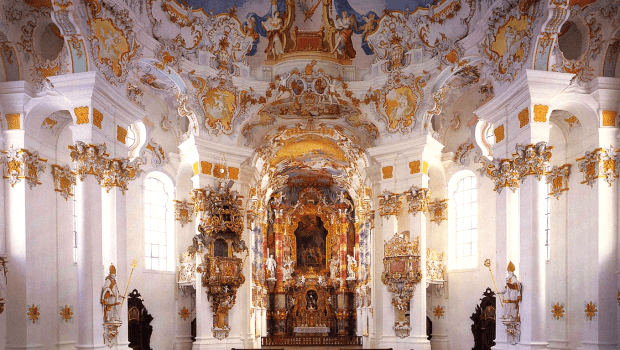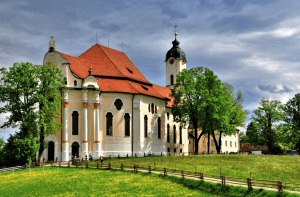
Art and Architecture:
The well renowned architect Dominikus Zimmermann and his brother Johann Baptist Zimmermann in the 1740’s were asked to assist in the construction of Wieskirche. They were experts of Baroque stucco and dedicated their scholarship in highlighting the Bavarian rococo form of architecture. The outside view might not give the appearance of its interior, but, upon entering the Church you will witness the overwhelming grandiose.
The Church was shaped in the form of an oval rococo which is significant of the “Late Baroque” period (18th Century movement art movement). Its chancel has an elongated shape matching the oval design, it was consecrated in 1749. The central part of the Church where the congregations are accommodated is where its famous eight snow-white pillars stand industriously holding the ceiling where the celebration of the resurrected Christ is depicted just above the nave. The frescos on the ceiling were painted by Johann Baptist Zimmermann on the other hand the stucco ornamentation was created by Dominikus Zimmermann. If you were to stand at one end of this construction the Holy image of Scourging at the Pillar could be seen right at the center. The splendid décor of the Church poses ubiquitous richness and unparalleled refinement.
The court painter of the Bavarian Prince Elector, Balthasar August Albrecht was the one who designed and painted the altarpiece. Furthermore, the beautifully ornate statues of the four fathers: Jerome, Ambrose, Augustine and Gregory the Great were created by Anton Sturm, a Tyrolean sculptor. The awe-inspiring creativity displayed by the then artisans is a magnificent feat of human ingenuity and faith. The free standing dome of the Church is an engineering marvel and must have definitely amazed the people of the time.
The current form the Church began with a small chapel. It was constructed in 1740. This chapel housed the wooden statue of Christ. Steingaden Abbey (dedicated to John the Baptist), a monastery located in Steingaden in Bavaria commissioned the construction of shrine as the chapel was much smaller in size and could not accommodate the rushing pilgrims. Its construction lasted almost nine years (1745 to 1754) and the interior sections were decorated with in the traditions of Wessobrnner School, which included frescoes and stuccowork. With the restoration work conducted between 1985 and 1991 Wies was restored to its former glory.
When visiting it would be ideal to get there on a bright sunny day as then you could see streams of sharp sun light passing through the high and large window displays and due to this the entire interior section seems to glitter. The vividly interplaying frescos, stuccowork, carvings, and statues appear animated and it is only then that the intricacies of the luminous ceiling can be viewed with precision.
Why visit?
The German National Tourist Board in its annual list of “Top 100 Sights of Germany” had placed Wies on the position of 59. In addition to that, the meadows around the Church are a symbol of peace and explicate the Romantic spirit of the times gone by.
Wies is not only a site of venerating pilgrims but, thousands of visitors also flock here every year to appreciate the mesmerizing rococo art and understand the long lost traditions of the ‘enlightenment age’. It is among the most beautifully coroneted Churches in Baroque. The rococo sculptures and frescos are the gem of human artistry and imagination. These are the reasons enough to just go and visit the place.
Guided tours are organized in different languages, though you will be required to make prior bookings of tours in languages other than English and German. The tour guides are trained so that they are able to explain the true sense and meaning of the Church. The special tours are needed to be paid for while there are also tours in general that are arranged free of cost.
Appropriate time for tourists is considered to be between May and October. Sightseers face certain restrictions when services are being performed, or during religious holidays or when special events are conducted. Therefore, it is advisable to time your visit carefully.
Furthermore, facilities for specially and differently abled individuals can be accessed from the south entrance side of the complex. In addition to these, guide dogs are also permitted while they are assisting their masters.
There is a café and souvenir shops in the building complex itself, so that you do not forget the mesmerizing site. Also, when visiting one must try and attend a few concerts that are organized by the Church. They include:
- Musik und Wort in der Wieskirche
- Festlicher Sommer in der Wies
- Musik im Pfaffenwinkel
- Werkgemeinschaft Musik, and
- Special Concerts
Opening hours:
- Open daily, 365 days of the year.
- Timings: Summer: 8 am to 8 pm, Winters: 8 am to 5 pm.
What else is around?
There is a nice little village resort of Steingaden located nearby which is also has a very famous market of historical value.
In addition to that there are also a few Inns and hotels near about the area along with diners and cafes. Dominikus Zimmermann, till the end of his life was closely associated with Wies and also had built a house for himself nearby. Today, his house has been remodeled and operates as an Inn.

